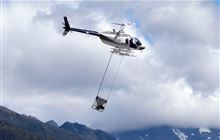1080 and hiking
Introduction
It's safe for people to walk in areas where 1080 has been applied.In some cases, public access may be restricted for tracks when helicopters are applying bait. Restrictions are usually only in place for 24-48 hours or less.
Aerial predator control operations are conducted by DOC’s National Predator Control Programme to protect native species.
How we notify the public
We want to ensure people are well-informed about how to keep safe when visiting areas where we are controlling predators. There are a number of ways we let people know about the location, timing and safety restrictions of 1080 operations on public conservation land:
- Signs are installed at key entrances to treatment areas prior to 1080 bait being applied.
- We put alerts on our website before, during and after operations are delivered.
- We publish notices in local community newspapers before bait is applied.
- We communicate with landowners adjacent to operational areas.
- Visitors can monitor the progress of predator control operations using our Pesticides summaries interactive map.
Know before you go
Find out about changes in conservation areas that might affect the safety or enjoyment of your trip.
Visit: Places to go: Parks and recreation to see if there is a 1080 operation alert in an area of your interest.
You can see if operations are planned up to a year in advance.
Visit National predator control operations for more information.
Keeping safe – people and dogs
When visiting an area where 1080 has been applied, there may be toxic carcasses and bait (green coloured pellets) in the area. Do not touch or remove them.
1080 is deadly to dogs. To keep them safe, they are prohibited from operational areas until poisoned carcasses have broken down. This can take up to 8 months. Visit How to keep dogs safe around 1080 for more information.
The tight regulations around the use of 1080 mean that people should not come into contact with it and drinking water supplies are safe. However, people are advised to be cautious when drinking from open waterways because there may be other contaminants present.
During predator control operations, 1080 from uneaten bait pellets can get into streams and rivers through runoff or directly from baits falling into streams. However, research shows there’s a very low risk of contamination. 1080 (sodium fluoroacetate) dissolves to harmless levels quickly when exposed to water. It's almost always undetectable in waterways after 24 hours.




